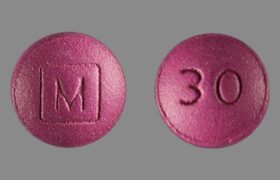M 30 Morphine Pill
The pill with the imprint 30 M is round, and purple, and has been recognized as 30 mg of extended-release morphine sulfate. Mallinckrodt Pharmaceuticals provides it.
Morphine is a member of the opioid medication class (narcotic analgesics) and is used to treat pain, chronic pain, and neonatal abstinence syndrome. Pregnancy cannot be considered risk-free. The Controlled Substance Act (CSA) lists 30 mg of morphine as a Schedule 2 controlled substance.
Here’s a table summarizing the key information:
| Attribute | Details |
|---|---|
| Availability | Prescription-only |
| Drug Class | Opioids (narcotic analgesics) |
| Pregnancy Category | C – Risk cannot be ruled out |
| CSA Schedule | 2 – High potential for abuse |
| Labeler / Supplier | Mallinckrodt Pharmaceuticals |
If you’re looking for substitutes for morphine, consider the following options, depending on the type and severity of pain:
Here’s a table summarizing morphine substitutes:
| Substitute | Description | Indication |
|---|---|---|
| Hydromorphone (Dilaudid) | Stronger than morphine, effective for severe pain | Severe pain |
| Oxycodone | Available in various formulations for moderate to severe pain | Moderate to severe pain |
| Fentanyl | Potent synthetic opioid; available as patches or lozenges | Severe pain management |
| Methadone | Longer duration of action, useful for chronic pain | Chronic pain |
| Buprenorphine | Partial agonist with lower risk of dependency | Pain relief |
| Tramadol | Milder option acting on multiple pain pathways | Moderate pain |
Always consult a healthcare provider for personalized recommendations.
M 30 Morphine Pill
Effectively managing extreme pain is essential for maintaining quality of life, and M 30 morphine frequently helps with this procedure. We’ll go over all you need to know about this medication in this blog post, including its uses, side effects, and alternatives.
1. Introduction to M 30 Morphine
M 30 morphine is an opioid prescription drug that is mostly used to treat moderate-to-severe pain. Comprehending its mechanism of action and possible ramifications can enable sufferers to make knowledgeable choices regarding their pain treatment tactics.
2. What is M 30 Morphine?
M 30 morphine is morphine sulfate in an extended-release version produced by Mallinckrodt Pharmaceuticals. The “30” denotes the dosage—30 milligrams of morphine per pill—while the “M” stands for the manufacturer. Because of the possibility of abuse, this potent drug is categorized as a narcotic analgesic and is subject to regulation.
3. How Does M 30 Morphine Work?
Morphine functions by attaching itself to opioid receptors in the brain and spinal cord, obstructing pain signals and changing how pain is perceived. When employed properly, this contact can greatly enhance a patient’s quality of life and assist reduce discomfort.
4. Common Uses of M 30 Morphine
M 30 morphine is prescribed in various scenarios, including:
- Post-surgical recovery: Managing pain after operations.
- Cancer treatment: Alleviating severe pain associated with cancer or its treatment.
- Chronic pain: Helping patients with long-term conditions like arthritis or fibromyalgia.
5. Dosage and Administration
M 30 morphine is often given orally, with the dosage determined by the individual needs and medical background of the patient. To prevent problems, you must strictly adhere to your healthcare provider’s directions.
6. Understanding the Risks and Side Effects
Like any medication, M 30 morphine comes with potential side effects. Common side effects include:
- Drowsiness
- Constipation
- Nausea
- Dizziness
You should consult a doctor right away if you have any strange symptoms or serious side effects.
7. Potential for Dependency and Misuse
M 30 morphine poses a risk of abuse and dependency, particularly in those with a history of drug abuse. Because of its significant potential for addiction, it is categorized as a Schedule II controlled substance. Patients must only take it as directed by their doctor and understand the warning signals of dependency.
8. Interactions with Other Medications
M 30 morphine may interact with a number of drugs, especially those that depress the central nervous system, such alcohol and benzodiazepines. To prevent possible harmful interactions, always let your healthcare provider know about any additional medications or supplements you are taking.
9. Special Considerations for Certain Populations
Certain populations may face additional risks when using M 30 morphine:
- Pregnant individuals: These can pose risks to the fetus and should be discussed with a healthcare provider.
- Individuals with respiratory issues: May experience heightened risks of respiratory depression.
- Older adults: May require adjusted dosages due to sensitivity to opioids.
10. Alternatives to M 30 Morphine
If M 30 morphine isn’t suitable for you, there are alternatives available:
- Hydromorphone: A more potent opioid for severe pain.
- Oxycodone: Available in various formulations for moderate to severe pain.
- Non-opioid options: Such as NSAIDs, physical therapy, and alternative therapies like acupuncture or chiropractic care.
11. Tips for Safe Use
To ensure safe usage of M 30 morphine:
- Always follow your doctor’s prescribed dosage.
- Never share your medication with others.
- Store the medication securely, away from children and pets.
- Regularly discuss your treatment plan with your healthcare provider to make adjustments as needed.
12. Conclusion: Navigating Pain Management with M 30 Morphine
M 30 morphine may, when used sensibly and under medical supervision, be a useful tool for treating severe pain. It is crucial to comprehend the advantages, drawbacks, and available options before choosing a pain management plan. To be sure you’re on the optimal course for your health and well-being, always discuss questions and concerns with your healthcare provider.
Sure! Here’s a frequently asked questions (FAQ) section regarding the M 30 morphine pill:
M 30 Morphine Pill FAQ
What is M 30 morphine?
M 30 is a pharmaceutical that comes with a 30 mg morphine sulfate prescription. Using this opioid analgesic, moderate to severe pain can be controlled.
How does M 30 work?
Morphine elicits a euphoric effect and helps to suppress pain signals by attaching to opioid receptors in the brain and spinal cord.
How should I take M 30?
- Dosage: Follow your doctor’s prescription. It’s crucial not to take more than directed.
- Administration: Take the pill whole with a full glass of water. Do not crush or chew it.
What should I do if I miss a dose?
Take the missed dose as soon as you remember it if you miss it. Do not take two doses if your next dose is soon due; instead, skip the missing one.
What are the common side effects?
Common side effects may include:
- Drowsiness
- Constipation
- Nausea
- Dizziness
What should I do if I experience severe side effects?
Seek medical attention immediately if you experience severe side effects such as:
- Difficulty breathing
- Severe drowsiness or confusion
- Allergic reactions (rash, itching, swelling)
Can I drink alcohol while taking M 30?
No, When alcohol and morphine are combined, there’s a higher chance of major adverse consequences, like overdose and respiratory depression.
Is M 30 addictive?
Yes, Morphine abuse and addiction are very likely. It should only be taken as directed by a doctor and under their supervision.
Can I take M 30 with other medications?
Always let your doctor know about all the medications you take, as some can interact with morphine and raise the possibility of negative side effects.
What should I do in case of an overdose?
Make an instant call to emergency services if you think someone may have overdosed. Severe sleepiness, labored or slow breathing, and loss of consciousness are possible overdose symptoms.
How should I store M 30?
The drug should be kept out of the heat and moisture in a safe location at room temperature. Keep it out of kids’ reach.
Can I stop taking M 30 suddenly?
Avoid stopping morphine abruptly without first talking to your doctor because doing so may cause withdrawal symptoms. Your physician might suggest a tapering regimen.
Who should not take M 30?
Morphine usage should be avoided by those with a history of substance abuse disorders, severe asthma, or specific medical conditions. Consult your physician for specific guidance at all times.
If you have more specific questions or concerns, it’s best to consult with your healthcare provider.
Certainly! Here are some references you can use for a blog post about M 30 morphine:
References
- U.S. National Library of Medicine. (2023). Morphine. MedlinePlus. Retrieved from medlineplus.gov
- Mayo Clinic. (2023). Morphine (oral route). Mayo Clinic. Retrieved from mayoclinic.org
- American Society of Health-System Pharmacists. (2023). Morphine. AHFS Drug Information. Retrieved from ashp.org
- Centers for Disease Control and Prevention. (2022). Opioid Overdose. Retrieved from cdc.gov
- National Institute on Drug Abuse. (2021). Is prescription opioid misuse a problem? Retrieved from drugabuse.gov
- World Health Organization. (2019). WHO Guidelines on the Pharmacological Treatment of Persisting Pain in Children with Medical Illnesses. Retrieved from who.int
These references provide credible information on morphine, its uses, risks, and management strategies. Be sure to access the most current data and guidelines when citing these sources.

